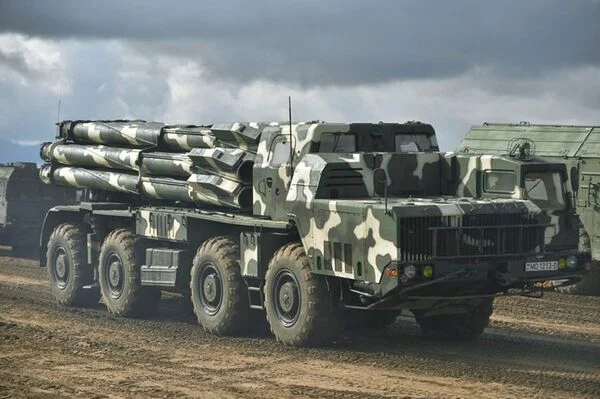| Ukraine conflict: Russian forces Tornado-S system employ 9M544 and 9M549 guided rockets
乌克兰冲突:俄军“龙卷风”Tornado-S系统使用9M544和9M549制导火箭 Date:2022-03-12 Source:janes By:Sunil Nair Viewed: |
11 MARCH 2022
by Sunil Nair
2022年3月11日
苏尼尔·奈尔

The BM-30 Smerch, recognisable from the distinctive MAZ-530M chassis. The Tornado-S is a deep upgrade to this system. (Russian MoD)
BM-30“龙卷风”(Smerch),可从独特的MAZ-530M底盘中识别出来。Tornado-S是对该系统的深度升级。(俄罗斯国防部)
Evidence is emerging from the conflict in Ukraine appearing to show that Russian forces are utilizing guided rockets – the 9M544 and 9M549 – with video and photographs of the remains of these types appearing across social media.
乌克兰冲突中出现的证据似乎表明,俄罗斯军队正在使用制导火箭——9M544和9M549——这些型号的残骸的视频和照片出现在社交媒体上。
The 9M544 and 9M549 are understood to be the latest guided rockets fired from Russia's Tornado-S system. According to official information, these have a range of 120 km and a circular error probable (CEP) of 5–10 m. Images of rocket fragments with the guidance and control unit code 9B706 have appeared in areas where the 9K515 Tornado-S multiple rocket launch (MRL) system has been active.
据了解,9M544和9M549是俄罗斯“龙卷风”Tornado-s系统发射的最新制导火箭。根据官方信息,其射程为120公里,圆误差概率(CEP)为5-10米。在9K515 Tornado-S多管火箭发射(MRL)系统活跃的地区,出现了制导和控制单元代码为9B706的火箭碎片图像。
The guided rockets have achieved an increase in range and accuracy over earlier types by equipping the nose module with cruciform aerodynamic rudders and integrating the 9B706 control system with on-board radio-electronic equipment.The 9B706 uses the CH398M strapdown inertial navigation system (SINS), which receives data from angular velocity and linear acceleration sensors. This, along with the GLONASS modules (also integrated into the 9B706 control system unit), provides a real-time data feed to generate an optimal quasi ballistic flight path for the 9M544 and 9M549 rockets.
通过为弹头模块配备十字形空气动力方向舵,并将9B706控制系统与机载无线电电子设备集成,制导火箭的射程和精度比早期型号有所提高。9B706使用CH398M捷联惯性导航系统(SINS),该系统接收来自角速度和线加速度传感器的数据。这与GLONASS模块(也集成在9B706控制系统单元中)一起,提供了实时数据馈送,为9M544和9M549火箭生成最佳准弹道飞行路径。
Furthermore, the rocket's apogee is in the upper layers of the stratosphere, thereby reducing drag and supporting the increase in range.
此外,火箭的远地点位于平流层的上层,因此减少了阻力并支持射程的增加。
The marked increase in accuracy versus earlier rocket types – for example, 9M55K (HE Frag) and 9M528 (HE Frag - parachute retarded) rockets, which have standard electronic time devices and a CEP of 150 m – is primarily due to the combination of the CH938M SINS and GLONASS.
与早期的火箭类型相比,精度显著提高——例如9M55K(HE Frag)和9M528(HE Frag——降落伞延迟)火箭,它们有标准电子时间装置,CEP为150米——主要是结合了CH398M捷联惯性导航系统(SINS)和格洛纳斯(GLONASS)卫星导航系统。
The Tornado-S is a deep upgrade to the BM-30 Smerch MRL system, which it will eventually replace. The BM-30 is a family of 300 mm MRLs, designed to provide indirect fires in depth and in support of large, combined arms operations. The family is based on a common chassis – a modified MAZ-543M 8×8 cross-country truck – which gives off-road mobility. It is designed for independent operations and can conduct so-called ‘shoot and scoot' tactics.
“龙卷风”Tornado-S是对BM-30 Smerch多管火箭发射(MRL)系统的深度升级,最终将取代该系统。BM-30是一个300毫米MRL系列,旨在提供纵深间接火力,并支持大型联合兵种作战。该系列基于一种通用底盘——一种改进的MAZ-543M 8×8越野卡车——提供越野灵活性。它是为独立作战而设计的,可以执行所谓的“射击和快跑”战术。
Externally, the Tornado-S launch vehicle appears almost identical to the baseline BM-30 Smerch 9A52-2, but for a GLONASS receiver mounted on the forward-left portion of the crew compartment. Moreover, beyond this external differentiator, the upgraded mission systems include an automated digital fire control system (FCS), which enables the launcher to be automatically aimed at target co-ordinates received over the battle management system. The crew can also undertake the fires mission from within the truck cabin, instead of from the post located on the rear-left of the launcher. The external post remains however, and this is thought to be as a manual back-up in case of emergency.
从外观上看,“龙卷风”Tornado-S运输车辆与基本型BM-30 Smerch 9A52-2几乎相同,但它的GLONASS接收器安装在乘员舱的左前方。此外,除了这个外部差异化之外,升级后的任务系统还包括一个自动数字火控系统(FCS),它使发射器能够通过战斗管理系统接收到的目标坐标自动瞄准。乘组人员还可以在卡车车厢内执行火力任务,而不是从位于发射器左后方的操作位置。然而,外部位置仍然存在,这被认为是紧急情况下的手动备份。
Russia deploys the Tornado-S system, or complex, in brigades of four battalions. A battalion consists of three batteries with four launchers in each. Accompanying each launcher is a 9T234-2 trans loader vehicle based on the MAZ-543A 8×8 chassis, and this carries 12 rounds and is equipped with a crane.
俄罗斯在旅中的四个营部署Tornado-S系统。一个营由三个连组成,每个连有四台发射装置。每台发射装置都配有一辆基于MAZ-543A 8×8底盘的9T234-2装载车,可携带12发火箭弹,并配有起重机。
Apart from the 12 launchers, the Tornado-S battalion includes the battalion and battery 1K 123 Vivary FCS and command-and-control (C2) units, which are housed in a K4310 fully enclosed box unit mounted on a KamAZ-4310 6 × 6 truck chassis. Each of these has its own power generator and a secure data and radio communications system that will support VHF communications to a range of 50 km and HF communications to a range of 350 km. The elements of the Vivary FCS can undertake automated or non-automated command-and-control of a Smerch-equipped MRL brigade.
除了12台发射装置,Tornado-S营还包括营和连1K 123 Vivary自动数字火控系统(FCS)和指挥与控制(C2)单元,这些单元位于安装在KamAZ-4310 6×6卡车底盘上的K4310全封闭箱式单元中。每一个都有自己的发电机和一个安全的数据和无线电通信系统,该系统将支持50公里范围内的VHF通信和350公里范围内的HF通信。Vivary FCS各分队可对装备Smerch的MRL旅进行自动化或非自动化指挥和控制。
The Command and Staff Vehicle (CSV) used by the brigade commander and brigade staff is also based on the KamAZ-4310 6×6. For the conflict in Ukraine, this vehicle may have been replaced by the MP32M1 unified C2 system, which is based on the KamAZ-43114 three-axle truck chassis equipped with the K4.5350 shelter. All brigade-level CSVs feature GLONASS/NAVSTAR receivers, other elements in the complex include the 1B44 meteorological station on an unarmoured ZIL-131 6×6 chassis, PM-2-70 MTO-V maintenance and repair unit also fitted to the ZIL-131, and the IT12M-2M topography vehicle which uses a GAZ-66 4×4 truck chassis.
旅指挥官和旅参谋使用的指挥和参谋车辆(CSV)也基于KamAZ-4310 6×6。在乌克兰冲突中,该车辆可能已被MP32M1统一指挥控制系统取代,该系统基于配备K4.5350掩体的KamAZ-43114三轴卡车底盘。所有旅级CSV均配备GLONASS/NAVSTAR接收器,该混成体中的其他元件包括1B44气象站,安装在无装甲ZIL-131 6×6底盘上,PM-2-70 MTO-V维护和维修装置也安装在ZIL-131上,以及IT12M-2M地形车,该车使用GAZ-66 4×4卡车底盘。
A lighter version of the Tornado-S launcher vehicle, the 9A52-4 (6 round) MRL, is a slim-line version of the original 9A52 and 9A52-2. With six launcher tubes instead of 12, it is fitted on a Kamaz-63501 four-axle 8×8 truck chassis and is designed to be air transportable and operated by a reduced crew. This version is understood to be under development and while many media outlets are referring to the Tornado-S deployed in Ukraine as the 9A52-4, there is not yet evidence of this variant having been deployed.
Tornado-S发射车的较轻型号9A52-4(6轮)MRL是原9A52和9A52-2的轻量型号。它有六根发射管,而不是12根,安装在Kamaz-63501四轴8×8卡车底盘上,设计为可空运,并由减少的人员操作。据了解,该型号正在开发中,虽然许多媒体都将部署在乌克兰的Tornado-S称为9A52-4,但目前还没有证据表明该型号已经部署。
In addition to the guided rockets, the Tornado-S can fire 9M55K rockets that carry 73 HE frag 9N235 or 9N210 bomblets, the anti-armour parachute retarded MOTIV-3F top attack 9M55K1 rocket, the anti-tank mine laying 9M55K4, the thermobaric fuel air explosive 9M55S, and the 9M55K7, which has a high-explosive anti-tank warhead, among others. These rockets also have extended range versions that enable them to engage targets at a range of 90 km.
除制导火箭外,“龙卷风”Tornado-S还可以发射9M55K火箭,携带73枚破片的9N235或9N210集束弹药、反装甲降落伞减速MOTIV-3F顶攻9M55K1火箭、9M55K4反坦克布雷火箭、9M55S和9M55K7热压燃料空气弹药,其中9M55K7具有高爆反坦克弹头。这些火箭也有增程型号,使它们能够在90公里的射程内攻击目标。
上一篇:没有了 下一篇:没有了
| Ukraine conflict: Russian forces Tornado-S system employ 9M544 and 9M549 guided
乌克兰冲突:俄军“龙卷风”Tornado-S系统使用9M544和9M549制导火箭 |
| The BM-30 Smerch, recognisable from the distinctive MAZ-530M chassis. The Tornado-S is a deep upgrade to this system. ... [2022-03-12] |
